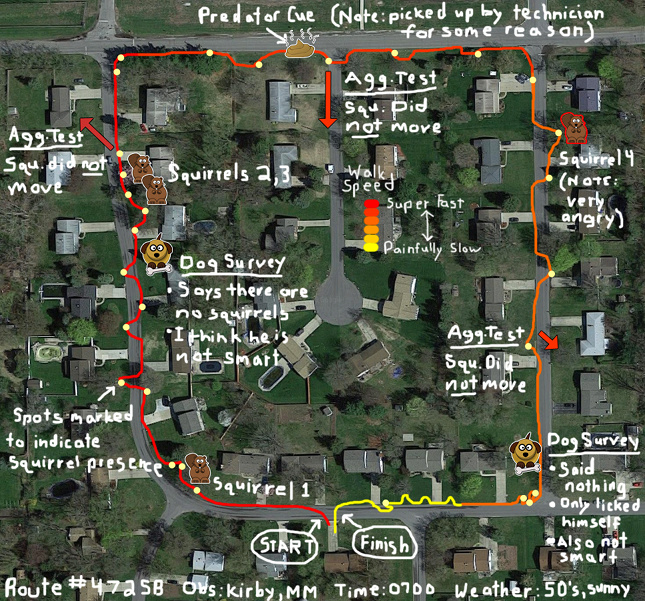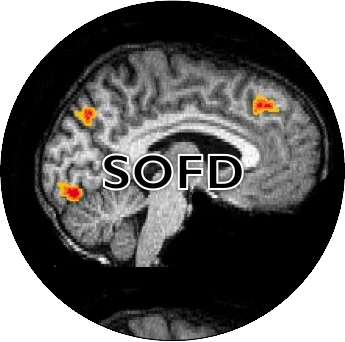
Tweet
November 19, 2015
Proceedings of the Natural Institute of Science | Volume 2 | SOFD 8
Dynamics and behavior of a local eastern gray squirrel (Sciurus carolinensis) population
Kirby Lindberg-Michel1
1 - Dog-in-Chief, PNIS

Editor's Note: On September 23rd, our company dog/head of security/chief purveyor of good feelings passed away from liver failure. Kirby was very fond of walks and, in his memory, we are publishing a scientific paper that we assume he would have written had he got the chance to write up the results of this extensive field work.
Introduction
Squirrels have long been seen as a nuisance among the dog community (see examples here and here). They are known to spread disease, spread pests such as fleas, and, in general, are just very annoying. Thus, it is in the best interest of the canine community to control and regulate their population sizes.
To date, the only strategy that us dogs have employed against squirrels have been chasing them (some examples from the scientific literature: Vatner et al. 1971, Black 1981, Bekoff and Meaney 1997, Svartberg 2004, Makowska and Kramer 2007), and remaining extra vigilant for their presence. While admittedly very fun and enjoyable, this method has not produced satisfactory results in controlling squirrel populations or curbing their aggravating personality. Thus, the goal of my research is to study a local population of eastern gray squirrels (Sciurus carolinensis) to determine how dogs can best go about the squirrel problem.
Methods
For the past 6 years, I have conducted four separate experiments to determine the population dynamics and behavioral responses of a small (~ 100 individuals) population of S. carolinensis. These experiments were carefully and deliberately crafted by myself and were performed with the help of several different human (Homo sapiens) field technicians. Humans were chosen because they seem to elicit few to no responses from squirrels and, for some reason, it is required by law for me to be accompanied by a human while outside. The use of humans in these experiments was approved by the local Animal Care and Use Committee (protocol number: 0063).
Experiment 1 (Squirrel census) – Twice a day (and sometimes three times a day, depending on the availability of the human field technician), I conducted census routes spanning roughly 1,000 m in length. On these routes, I counted every squirrel I saw and barked this information to my field technician to write it down. I also marked the location of every squirrel using urine (mine, not the technicians).
In addition, every 10 meters along these census routes I stopped to sniff for any olfactory evidence of squirrel presence. The length of these sniffs varied from 10 seconds to 10 minutes.
For the past 6 years, routes were conducted in the morning and evening every day (including holidays, rainy days, very cold days, very hot days, mornings after an ice storm, during hurricanes, and days in which the human field technician drank a lot from various bottles the previous night) for an approximate total of 4,500 censuses. Figure 1 gives a map of an example census route. Note that these maps were made immediately after returning from a census.
Experiment 2 (Behavioral response to aggression) – On some walks, randomly selected squirrels were subjected to a response to aggression test. For this test, the squirrel was first approached and then barked at, and its response was noted. If the squirrel gave no response (which was often), I gave a mock chase to the squirrel and noted its response. If there was still no response, I walked brusquely away to retreat.
Experiment 3 (Behavioral response to predator cues) – Experiment 2 above focused on a squirrel’s reaction to direct aggression. Experiment 3 was designed to determine how squirrels respond to more indirect type of aggression, specifically, some environmental cue that indicated a predator was present. I used myself as the predator, and left one big pile of cue at a random location during each census.
Experiment 4 (Opportunistic dog survey) – Occasionally, I would encounter other dogs on my censuses. I gave each dog a brief survey in which they indicated, in their opinion: 1) the current size of the squirrel population and 2) the current level of aggression of the squirrel population and 3) places along my route where someone may have dropped a piece of food (specifically, chicken wing bones).
Statistical Analyses – All statistical analyses were done by my field technicians using PAWSS (Postulates Analyzed With Statistical Software) Version 12.0.
Results
Experiment 1 (Squirrel census) – The average number of squirrels (± 1 SD) seen on a census route was 5.2 ± 2.3 squirrels. Most squirrels were spotted in areas that provided adequate refuge from ground predators (such as in trees, or on the other sides of fences). I suspect that someone or something had alerted them to my presence (like those stupid birds), thus my counts might have been biased.
Over the 6 years of my census routes, there was a steady increase in the number of squirrels spotted per walk. Initially, I would spot about 4.1 squirrels per walk, but this average grew to 6.3 squirrels per walk in the last year. Clearly, the squirrel population in this neighborhood is growing exponentially and must be dealt with accordingly. While I am not absolutely sure why the squirrel population had increased dramatically, I feel somewhat confident that it is the fault of cats.
Experiment 2 (Behavioral response to aggression) – I conducted about 2 aggression tests per census route. For the initial test of aggression (i.e., being barked at), not one single squirrel gave any sort of response. For the elevated test of aggression (i.e., being chased at), most squirrels scurried up trees. A few squirrels stood their ground, which forced me to retreat (as per the Animal Care and Use protocol), and I’m pretty sure one squirrel threw an acorn at me. However, my technician could not confirm this. Similar to squirrel population size, squirrel aggression levels also increased over time. Thus, the boost in population numbers appears to have made them more brazen.
Experiment 3 (Behavioral response to predator cues) – Unfortunately, I was never able to get any data from this experiment because my technicians, for unknown reasons, picked up every pile of predator environmental cue I left, placed it in a bag, and threw it in a trash can. I would have fired them, if they didn’t always carries delicious treats with them on my routes.
Experiment 4 (Opportunistic dog survey) – I started to conduct about 1 to 2 dog surveys per census route, but based on the responses I received from dogs (see Figure 1 for a typical example), I slowly reduced the frequency of these surveys. Most dogs seemed to be completely oblivious to the presence of squirrels and then began to bark incoherently. Other dogs were too interested in sniffing me and avoided any questions. Overall, I learned that most other dogs have no idea what they’re talking about and no usable data was obtained from these surveys.
Conclusions
These appear to be troubling times for our struggle against the squirrels. Local populations of squirrels are increasingly rapidly, squirrels do not seem to be intimidated by displays of aggression by dogs, and most other dogs are completely oblivious to squirrels. It is clear that more work needs to be done before we are ever able to gain the upper paw against them. Accordingly, it is my hope that this paper will inspire other dogs to study their local squirrel populations and their behavioral characteristics. At the very least, field work is a good way to get exercise. And the technicians seem to enjoy it.
Acknowledgements
I have many people to thank, but first and foremost, I would like to thank the many technicians who accompanied me on my census routes, specifically AJL and MJM who were my primary assistants. I would also like to thank the other technicians including: WLM, CMM, APM, EPM, AMG, JG, JEM, KSM, JL, AL, JL, VL, AF, KK, DC, LK-C, TP, BW, BW, CEP, BP, LS, and TF. I couldn’t have done this without your help. You helped make an old dog very very happy.
In Memory, Kirby Lindberg-Michel (2003 - 2015).


More Articles Below!

Proceedings of the Natural Institute of Science (PNIS) by https://instsci.org/ is licensed under a Creative Commons Attribution-ShareAlike 4.0 International License.



